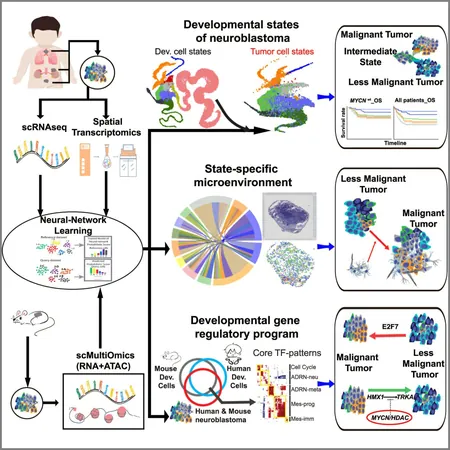
Unlocking the Secrets of Neuroblastoma: The Game-Changing Discovery That Could Save Lives
2025-05-12
Author: Rajesh
High-Risk Neuroblastoma: A Deadly Challenge
Neuroblastoma, a highly aggressive childhood cancer, strikes fear as it claims the lives of nearly half of the children diagnosed. Its most insidious trait? The ability to switch its cellular identity, allowing it to escape conventional therapies. But now, researchers at Karolinska Institutet have forged a groundbreaking path to understanding this malignant behavior.
A Revolutionary Cell-By-Cell Map Unveiled
By employing cutting-edge single-cell multi-omics alongside spatial transcriptomics, these researchers have crafted an intricate roadmap revealing how neuroblastoma cells transition from one state to another. Their findings, published in the prestigious journal Developmental Cell, pinpoint a hidden intermediate state that plays a pivotal role in this process.
Epigenetic Landscapes and Transcription Factor Switches
The team has identified an enhancer-primed epigenetic landscape, which equips neuroblastoma cells with an astonishing ability to shift between differing developmental programs. Crucially, they found key transcription-factor 'switches' that, when inhibited, can essentially lock the cancer cells into a less aggressive form—offering a beacon of hope for new therapeutic avenues.
Revolutionizing Treatment Strategies
Yizhou Hu, a leading researcher in the study, emphasizes the monumental implications of their discoveries: "High-risk neuroblastoma remains deadly largely due to its ability to adapt and alter its transcriptomic identity. Our research highlights a crucial 'bridge' cell state that facilitates this adaptability and reveals the gene regulatory networks behind it. This provides clear molecular targets for new drugs and combination therapies."
The Tumor Microenvironment: An Unsung Adversary
The investigation also casts light on the tumor microenvironment’s role in maintaining these aggressive cell states. Tumor-associated macrophages and cancer-associated fibroblasts were found congregating around bridge and neural crest-like tumor cells, bolstering their menacing behavior.
Unlocking New Treatment Potentials
Experts now advocate for focusing on these newly identified transcription factor switches or the supportive microenvironment as potential targets. By locking tumors into a less dangerous state, researchers could significantly boost the effectiveness of current treatments. Furthermore, a diagnostic test measuring the proportion of bridge/neural crest state cells may soon empower clinicians to tailor therapies more accurately for each patient.
A Beacon of Hope for the Future
As science continues to unveil the complexities of neuroblastoma, these findings mark a pivotal step towards innovative treatments that could transform outcomes for affected children. The journey to conquer neuroblastoma is still underway, but with every discovery, hope shines brighter.


 Brasil (PT)
Brasil (PT)
 Canada (EN)
Canada (EN)
 Chile (ES)
Chile (ES)
 Česko (CS)
Česko (CS)
 대한민국 (KO)
대한민국 (KO)
 España (ES)
España (ES)
 France (FR)
France (FR)
 Hong Kong (EN)
Hong Kong (EN)
 Italia (IT)
Italia (IT)
 日本 (JA)
日本 (JA)
 Magyarország (HU)
Magyarország (HU)
 Norge (NO)
Norge (NO)
 Polska (PL)
Polska (PL)
 Schweiz (DE)
Schweiz (DE)
 Singapore (EN)
Singapore (EN)
 Sverige (SV)
Sverige (SV)
 Suomi (FI)
Suomi (FI)
 Türkiye (TR)
Türkiye (TR)
 الإمارات العربية المتحدة (AR)
الإمارات العربية المتحدة (AR)